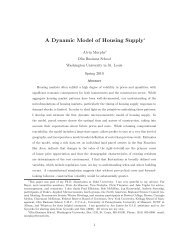Shopping Externalities and Self Fulfilling Unemployment Fluctuations*
Shopping Externalities and Self Fulfilling Unemployment Fluctuations*
Shopping Externalities and Self Fulfilling Unemployment Fluctuations*
Create successful ePaper yourself
Turn your PDF publications into a flip-book with our unique Google optimized e-Paper software.
the paper, which is mainly devoted to characterizing the set of rational expectations equilibria,it is more convenient to work in continuous time. We formally derive a continuous-timeversion of our discrete-time model in Appendix B. There, we assume that, over a period oflength , the technology parameters are k, , y e <strong>and</strong> y u , the preference parameteris <strong>and</strong> the matching function is M(u; v). We then take the limit as goes to zero<strong>and</strong> obtain the continuous-time equivalent to the equilibrium conditions (10) <strong>and</strong> (12). Thisleads to the following de…nition of equilibrium for the continuous-time version of the model.De…nition 2: A continuous-time Rational Expectation Equilibrium is a path fu t ; J t g suchthat:(i) For all t 0, J t satis…es the Bellman Equation( + ) J t = (1 ) (S(u t ) + y e y u ) + J t ; (14)(ii) For all t 0, u t satis…es the law of motionu t = u t ((J t )) + (1 u t ); (15)(iii) lim t!1 J t is …nite <strong>and</strong> u 0 is given.3 Characterization: Multiplicity <strong>and</strong> CyclesIn this section, we characterize the set of rational expectations equilibria for the model economydescribed in Section 2. We accomplish this task in three steps. In the …rst step, weidentify necessary <strong>and</strong> su¢ cient conditions under which the model admits multiple stationaryequilibria. In the second step, we characterize the set of non-stationary equilibria in aneighborhood of the steady states by studying the properties of a linearized version of thedynamical system (14)-(15). In the last step, we characterize the entire set of rational expectationsequilibria by studying the global properties of the dynamical system (14)-(15). We…nd that, for some initial conditions on the unemployment rate, the model admits multiplerational expectations equilibria which di¤er with respect to the agents’(self-ful…lling) beliefsabout future unemployment. Moreover, we …nd that some of these equilibria lead to di¤erentsteady states. Hence, agents’expectations about future unemployment can have such astrong impact on individual behavior so as to a¤ect long-run outcomes in the economy. Thefundamental reason behind the multiplicity of equilibria is the feed-back between agents’beliefs about future unemployment <strong>and</strong> the current value of hiring a worker <strong>and</strong>, hence, tocreate vacancies.15
















